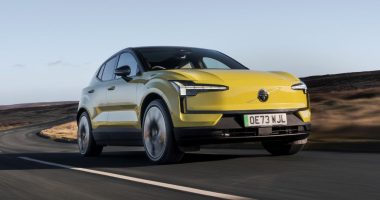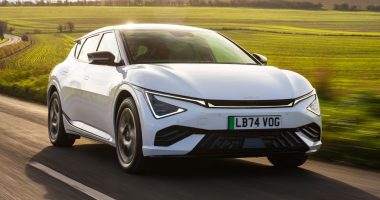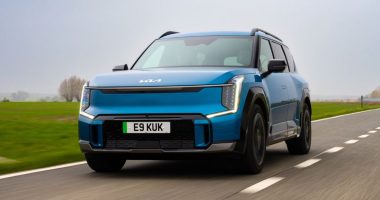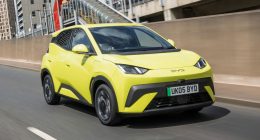If there is a single car that has helped transform public perceptions of what was once a left-wing brand, the seven-seat Sorento makes a compelling case for itself. Over the years, with every new model, Kia has used it as the vehicle to highlight the technological and engineering advances it has made – a theme that continued when the fourth-generation model arrived in summer 2020.
The look was big and undeniably bold and, truth be told, it was ageing well. However, the time has arrived for the mild hybrid-, diesel- and plug-in-powered SUV to undergo the customary mid-life refresh. Built in entry-level ‘2’, mid-range ‘3’ and top-of-the-line ‘4’ grades, the bulk of the changes revolve around the Sorento’s nose which is said to draw inspiration from the brand’s flagship SUV – the much larger albeit fully electric EV9 which you can find out more about by clicking here.
The correlation between the two is obvious – but the execution of the vertical headlights with ‘star map’ DRLs on the Sorento, and their integration with the reprofiled bumper, and fresh bonnet design where the Kia logo is now perched, is arguably less successful. At the rear, the tweaks are less obvious and comprise chunky n-shaped tail-lamps, an updated bumper and exhaust trim.
The size and design of the two-tone alloy wheels depends on which trim you choose. On our ‘2’ example, which had the self-charging set-up – a 1600cc, four-cylinder turbocharged petrol engine badged ‘T-GDi’ paired to a 1.49kWh lithium-ion battery for a 212bhp power output – sat on 17s that prioritise ride quality and cushioning over driver engagement and responsiveness. These also complement the chrome edging around the window line, and silver garnishes that adorn the two front wings and accents that reach almost the entire length of the door sills. In terms of colour choice, the previously seen hues of ‘Mineral Blue’, ‘Midnight Black’ and ‘White Pearl’ have been carried across and are joined by new ‘Interstellar Grey’, ‘Cityscape Green’ and ‘Volcanic Sand’.
Of the three powertrains, the regular petrol hybrid is the least efficient, so is probably the go-to-choice if you spend the bulk of your time in town – or undertaking short journeys (trips to the supermarket, school pick-up and drop-off, or generally performing the role of ‘Taxi of mum and dad’). It never feels particularly punchy, and the lazy six-speed automatic does not really help matters, either, but one upshot is the 86bhp electric motor on the front axle. It takes over for short bursts at speeds up to 33mph and is pretty keen when it does thanks to the big punch of torque. Although the Korean load lugger is not going to get pulses racing from the driver’s seat, steering that grows in feel as your speed rises, and road-holding that is assured, are both big plus points.
As you would expect from a vehicle at this price point (£41,995) the interior – which is broadly unchanged from the pre-facelift model – is well protected from any wind or road noise, ensuring it is serene and conversations can be had with regardless of where you sit without needing to ever raise your voice. In the case of the rearmost seats, access is made easy by chairs in the second row that slide and recline at the tap of a button. With the caveat the journey is relatively short due to the high floor forcing adult passengers to bunch their knees up, even six footers can use the third row: when in use, boot space drops from 813-litres to 179 – enough for modest shopping.
Up front, the new Sorento benefits from Kia’s latest dash layout as seen in the EV6 and EV9, so that means tangible knobs and switches make way for a slim strip of touch-operated buttons for climate control, audio, and media functions. We are not particular fans of going down this route, as plenty of manufacturers have been, so we are pleased to report that these rank as the best in the business right now. The big difference is the 24.6-inches of curved display screen that is split into two, 12.3-inch halves – one for the driver’s display and one for the infotainment system.
In ‘3’ and ‘4’ trim this creates the impression of a single pane – and it works (and looks) well as the sharp graphics make reading information easy on the move. On ‘2’ models, you must make do with a poultry 4-inch liquid crystal driver display. Entry-level examples come with artificial leather covered chairs, heated front seats, rain sensing wipers, and a reversing camera. If bigger wheels, privacy glass and a 360-degree parking camera is your thing, all cost more, with a panoramic sunroof, Nappa leather, and a head-up display exclusive to Sorento’s in lavish ‘4’.









